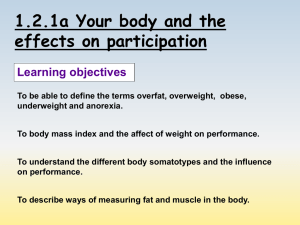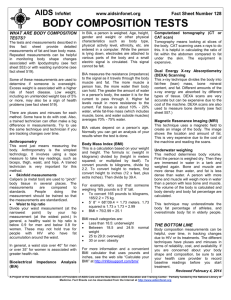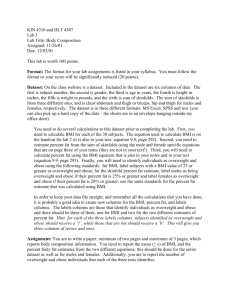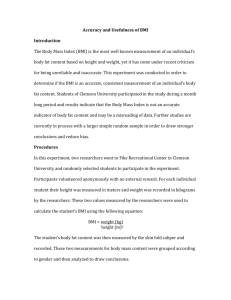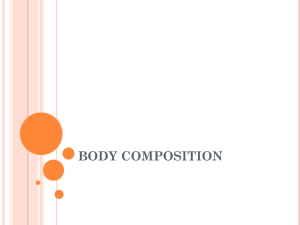1.2.1a_-_Your_body_-_Weight
advertisement
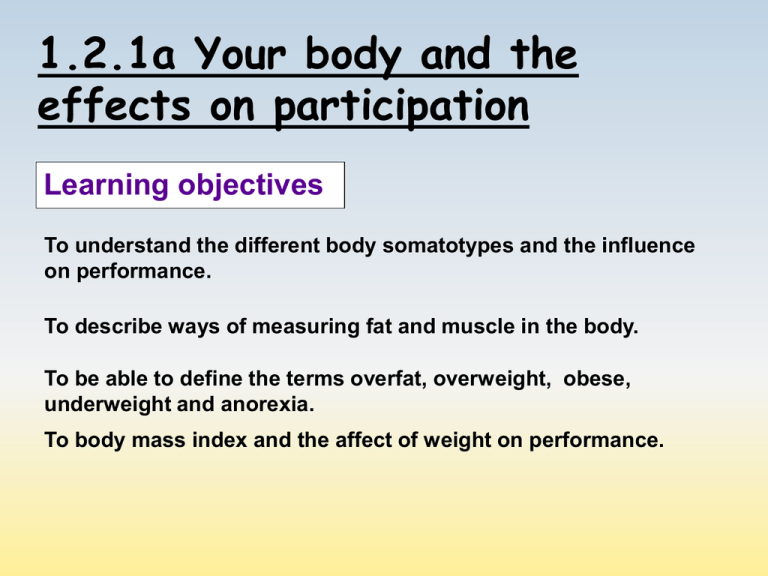
1.2.1a Your body and the effects on participation Learning objectives To understand the different body somatotypes and the influence on performance. To describe ways of measuring fat and muscle in the body. To be able to define the terms overfat, overweight, obese, underweight and anorexia. To body mass index and the affect of weight on performance. STARTER ACTIVITY - 3 Categories of Body Type Using only ADJECTIVES, describe the three body shapes below. List as many adjectives for each as you can. How would body weight affect participation in sport? TASK: Explain how the correct body shape would give a player an advantage in the sport above? How would body weight affect participation in sport? -Fatigue quickly -Speed when playing/speed of movement -Strength levels -Flexibility may be affected -The need for more weight in certain activities i.e. Rugby prop Somatotypes Somatotyping is a method of determining an individuals body shape Body shape is determined genetically (born with it). It can be improved but not dramatically changed 3 Basic Somatotypes 1. ENDOMORPH (Fat) Wide hips and Narrow shoulders Shot putters, sumo wrestlers. 2. MESOMORPH (Muscular) Narrow hips and broad shoulders Tennis, rugby, sprinters & swimmers 3. ECTOMORPH (Thin) Narrow hips and shoulders High jumper, marathon runner Somatotypes Somatotype is important, it may mean that you are better suited to one sport more than another. Many people are a normal shape – not an extreme body type. You can be a mixture of body types. Somatotypes Each of the three categories is classified on a scale from 1 to 7. You cannot score highly on all three. The three numbers together give a somatotype number, with the endomorphy score first, then mesomorphy and finally ectomorphy (e.g. 1-5-2). Your score depends on your FAT, MUSCLE and BONE ratio. For example: Remember these are EXTREME body shapes! 7,1,1 1,1,7 ENDOMORHY 1,7,1 MESOMORHY ECTOMORHY Measuring the body To assess suitability for as particular sport you can measuring the ratio of the body. Fat levels vary depending on age and gender. Measuring fat levels can be done with skin fold callipers. (remember we all need a certain amount of fat!!!) Measuring muscles should be done when the muscle is flexed. TASK: Pupils to measure skin fold (calf, bicep, tricep, abdominals) and muscle girths (waist, calf, thigh, bicep flexed and relaxed). What Somatotype Plenary? Give a estimate of a somatotype score for each. Body Weight There is a clear link between calorie intake, exercise levels and weight. Every person has an optimum weight. This depends on a number of factors: -Height -Gender -Bone structure Body Weight Some athletes need to maintain their weight carefully (i.e. boxers and jockeys) The table shows a weight guide based on height Overweight A person who is significantly heavier than their optimum weight is classed as overweight. - “having weight in excess of normal” Extra weight can be in the form of muscle mass. Overfat However, if the extra weight is in the form of fat, then the person is classed as overfat. - “is an abnormally large percentage of their body is composed of fat” Do you know what this can lead to: High Blood Pressure Strokes Heart Attacks Obesity Obese people are people who are Extremely overfat. Men are obese if more than 25% of their body is fat. Women are obese if more than 30% of their body is fat. Obesity is very damaging to health and the risk of diabetes, high blood pressure and heart disease are much GREATER. Underweight People who are underweight are 10% under optimum weight. This can lead to: -Women have irregular periods -Can lead to malnutrition -Poor health -Energy drain Weight loss should be gradual and realistic. Dieticians will oversee weight loss and ensure it is safe. Anorexia Excessive weight loss can lead to a disorder called anorexia nervosa. Individuals with anorexia do not eat because they see themselves as fat. There mind state means they dramatically reduce their food intake. Anorexia can also be linked with depression and can result in kidney damage and even death. Body mass index (BMI) BMI is a general way of working out whether a person is the right weight for their height. Use the following formula: BMI = Weight (kg) Height (m) x Height (m) TASK: Calculate your BMI. You do NOT have to this if you don’t want to! BMI Categories for adults: Underweight = <18.5 Normal weight = 18.5–24.9 Overweight = 25–29.9 Obesity = BMI of 30 or greater Body mass index (BMI) Generally the higher the BMI the more % body fat, but elite athletes with have a high % body mass due to muscle weighing more than fat. This is an adult chart but gives you an idea.
